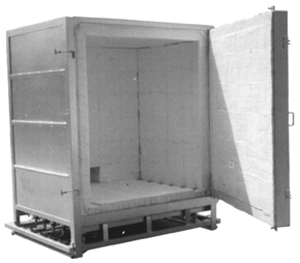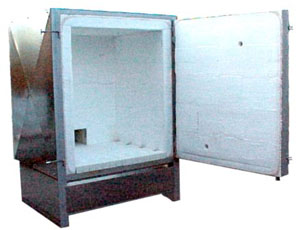
|
|
|
| Fiber
Lined Front Loading Kilns
|
GEIL
Natural Draft Kilns
The frame construction of all GEIL Fiber Lined
Natural Draft Kilns consists of heavy gauge
structural strength steel. All frames are
welded at each joint, providing maximum strength
and durability. The exterior consists of a
dual-wall type construction using 9 gauge
expanded metal with galvanized sheet metal.
An air gap is provided between the two, producing
a cooler exterior temperature.
Each model has full width, front loading doors
and has been specifically designed to minimize
the area between the door opening and the
setting space, alleviating strenuous loading
and unloading
The ceramic fiber interior lining consists
of a two-stage component system featuring
a high density, 12 lb. Monolithic Block and
a high density, 12 lb. Edge Grain Veneer Facing.
Each Monolithic Block is attached to the shell
with a stainless steel attachment clip and
sealed with a high temperature sealant. The
12 lb. Edge Grain Veneer is attached to form
the Hot Face capable of temperatures to 2500°
F (cone 14).
All ceramic fiber materials used in the construction
of GEIL Kilns have been specifically designed
and manufactured to GEIL specifications for
high fire applications. Each kiln comes equipped
with natural draft, high velocity, ceramic
venturi burners specifically designed and
developed by GEIL Kilns to produce excellent
fuel-air mixture without the need of electric
blowers. These burners provide for simple
and trouble-free firing. |
| 
Fiber
Lined Natural Draft Kiln Model
DL-60F |
|
|
|
|
-
Electronic
flame safety, 100% Shut Off
-
Push
button automatic spark ignition
-
Manual
control valve
-
0-15"
water column pressure gauge
-
DD-1
digital, solid state, electronic
controller which functions as a
high-limit, on/off soaking controller
|
|
The use of
ceramic fiber as a kiln insulator offers
the kiln user several important advantages
over kilns constructed with a conventional
refractory insulation.
Lightweight: Ceramic fiber linings
are 75% lighter than insulating fire brick
linings and 90-95% lighter than dense refractory
linings.
Low Heat Storage: Low heat storage
is the most important advantage of a ceramic
fiber lining. Heat storage is directly proportionate
to the weight of the material used in the
kiln lining. The lighter the lining, the
fewer BTUs needed to bring the kiln up to
temperature. The BTUs required to fire is
directly related to energy consumed. Thus,
the fewer the BTUs consumed, the more energy
conserved.
Moreover, the kiln can achieve its maximum
temperature more quickly and can cool down
faster over kilns constructed with insulating
fire brick. Shorter operating cycles increase
productivity and save wear and tear on the
kiln.
Thermal Shock Resistance: Fiber linings
are completely immune to damage from thermal
shock. Therefore, predetermined heat up/
cool down cycles dictated by the kiln's
lining are eliminated. Once the firing cycle
is completed, access to the kiln can be
immediate without fear of damaging the lining.
Thermal Efficiency: Fiber linings
are thermally more efficient then conventional
refractory linings. The low thermal conductivity
of fiber means the lining thickness can
be reduced, thereby decreasing outside dimensions.
Additionally, fiber heats at a more uniform
rate, allowing for a more uniform temperature
distribution within the kiln chamber.
|
Resiliency:
In that fiber is extremely resilient and
withstands movement well, kilns are transported
easily without fear of damage. Kilns are
test fired in our factory prior to shipping
which eliminates any possible problems before
they start.
Ease of Repair: Should physical damage
to the lining occur, the damaged section
is simply cut out with a knife and new material
inserted. Repairs are made quickly with
a minimal amount of expense and downtime.
Energy Savings: Research has shown
that ceramic fiber kilns conserve as much
as 30-40% in energy over comparably sized
insulating fire brick kilns. Such tremendous
savings means much faster payback periods.
Cool
Down: All GEIL fiber kilns have been designed
and engineered to insure a cool down rate
equal to that of similar sized brick kilns.
Cool down can be easily controlled by damper
adjustments. A normal cool down requires the
damper to remain closed. This may be hastened
by opening the damper slightly. |
| 
Fiber
Lined Natural Draft Kiln Model
DL-30F |
|
|
Specifications
- Fiber Lined Front Loading Natural Draft Kilns
| |
GEIL Forced
Draft Kilns
Forced Draft models are the same superior
construction technique as that of the Natural
Draft models, with the exception of the
burner system. A standard Forced Draft system
incorporates the use of an electric blower
to force air through the burners to insure
complete combustion. Call for Specifications
and Pricing.
|
|
|
|
|
|
|
|
